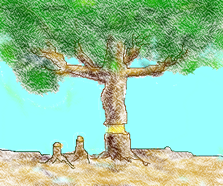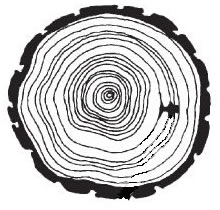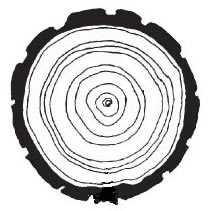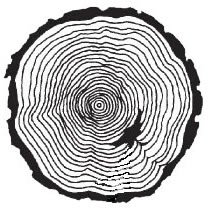3rd Grade - Tree rings - Life Science - Growth; Inquiry Process - Observation, variables, classification
Overview
Science content focus - what science says - enduring understanding, big ideas, generalizations
Science inquiry focus - how we use science to collect information to understand
Activity sequence
Resources and materials
Pedagogical ideas
Lessons and activities detail
Assessment
Overview
Students observe different slices of trees, photos, and diagrams of tree rings to organize observational information as it relates to changes in tree growth as a result of environmental factors.
![]()
Life Science - growth related to the environment
(what science says - enduring understanding, big ideas, generalizations)
Animals consume energy and plants use sunlight to make their food. All living organisms have basic needs, (animals need air, water, food, and shelter; plants need air, water, light, food, nutrients, and shelter). The quality of life, health of an organism depends on kinds of and amounts of environmental factors for the organisms that live there.
Related concepts and facts -
- Living organism change and grow.
- Organisms can survive only in environments in which their needs can be met (animals need air, water, food, and shelter; plants need air, water, light, nutrients, and shelter)
- One ring per year, with the outer most ring telling the current growth story
- The only living part is in the outer ring
- Generally the larger the ring the better the climate conditions (sun, rain, temperature, wind) and other environmental factors (insects, disease, fire, lightning, humans)
- Smaller rings or abnormally shaped rings shows negative effects from: animals, disease, insects, fungi, fires, weather: flood, drought, lightening, wind, hail, tornadoes, erosion, ice, frost...
- Different environments provide different kinds of and amounts of environmental factors for the organisms that live there.
Outcome - Life Science - growth related to the environment
Describe how the basic needs of an organism being met or not meet can be observed in how the organism grows.
Specific outcomes -
- Describe a tree as living and changing as a result of its interactions with its environment.
- Describe tree rings as observable result of a tree's needs being met or not met.
- identify heartwood, sapwood, growth ring, bark, twigs, trunk, leaves, roots, and the function of each.
- Identify environmental factors that effect tree growth- temperature, water, light, human intervention, floods, wind, lightning, fire
![]()
Inquiry - processes - constancy, change, measurement - observation
Observations are conditions or properties that can be described. Change is recognized by comparing observations.
Related concepts and facts -
- Observations are used to help make explanations.
- When people disagree on explanations for an observation they usually make more observations to refine their explanations.
- Observation, creativity, and logical argument are used to explain how things work.
Outcome - Inquiry - processes - constancy, change, measurement - observation
Describe how properties can be used as variables and describe how variables can be used to explain changes.
Specific outcomes -
- Identify properties of tree rings and describe how different shapes can explain conditions that affected the tree's growth.
- Tree rings vary in width.
- Width can be related to growth and environmental conditions.
- Other markings can be related to fires, scars...
![]()
Inquiry - processes - constancy, change, measurement - variables
Variables are properties/ characteristics that change and effect outcomes.
Related concepts and facts -
- Variables are properties/ characteristics that change and effect outcomes.
- Variables include, size, shape, color, temperature, amount, volume, rate, ...
Outcome - Inquiry - processes - constancy, change, measurement - variables
Variables are properties/ characteristics that change
Specific outcomes -
- Identify variables and suggest how they change (climate - wetter, drier, warmer, cooler; weather - lightning, fire, hail, wind...).
- Identify variables and describe how they are conditions that can be changed and how that change can affect observations (outcomes) [(wind - breaks branches, fire/ lightning - burns bark and cambium, .
![]()
Inquiry - processes - evidence, models, explanations - operational definition
Scientists use operational definitions to describe how one variable relates to another. Variables and describe how they operate to effect observations (operational definition).
Related concepts and facts -
- Variables are properties/ characteristics that change and effect outcomes.
- Variables include, size, shape, color, temperature, amount, volume, rate, ...
- Operational definition describes how one variable relates to another.
- Operational definitions can be used as an explanation.
Outcome - Inquiry - processes - evidence, models, explanations - operational definition
Identify variables and describe how they operate to effect observations (operational definition).
Specific outcomes -
- Use variables to see if there are patterns or relationships to use as explanations (variables that affect tree rings from one tree to another in similar ways).
- Identify variables and describe how they operate to effect other variables. (operational definition). Increase sun, and water to optimal conditions and the size of the ring increases.
- An insect would be a variable that might effect how a tree grows. If the insect damages the tree and the tree continues to survive the tree will grow around the damaged area and could eventually surround the damaged area. Variable - damage done by insect and variable how tree grows. Relating them together creates an operational definition.
![]()
Activities
to provide sufficient opportunities for students to attain the targeted outcomes.
Possible Activity Sequence
- Read story - Giving Tree
- Discuss how trees grow and list variables that might affect tree growth
- Create tree slice with yarn or clay rings.
- View cross sections of trees and discuss what different shapes of rings might represent tree
- Discuss trees in neighborhood, visit, take photographs...
- View pictures of tree rings ...
- Can a twig's age be determined with observation?
![]()
Pedagogical ideas
Focus questions - What is living? How do trees grow? What are the parts of a tree? What variables effect the growth of trees? What environmental factors would effect the growth of trees?
![]()
Exploration
Activity
Materials: Tree rings, magnifying glasses,
Activity 1
Book share for - What is living? What is growth? What variables affect growth?
Read a story that includes something about trees. (maybe Shel Silverstein - Giving Tree)
Ask students to discuss trees. Ask about size, shapes, changes, and other characteristics of trees.
Was the tree alive? Is it living? Why? What do living objects do?
Create a list of characteristics (properties) of living objects.
Activity 2
Ask if the tree grew? How do they know?
What is growth?
What characteristics of trees can be used to represent growth?
Ask what caused the tree to change?
What do you think are the variables that caused the tree to grow or change how it grew?
Create a list of variables that might affect tree growth.
Then add two columns to the list and make a chart (Column one variable that affects growth, second possible affects, three negative affects)
| Variables that affect tree growth | How could the variable help the tree grow better? | How could the variable negatively affect the tree growth? |
| 1 | ||
| 2 | ||
| 3 | ||
| 4 | ||
| 5 | ||
| 6 |
Activity 3
Ask students to create a representation of a tree cross-section by rolling year or clay in rings or using yarn. Use different colors to represent different rings and create a short story about the growth of their "tree".
Activity 4
Ask student if they can think of what evidence might be available to know how these different variables affected the tree?
Do you think there is evidence that could be used to know the history of how a tree grew over the years it was alive?
Show students a cross-section of a tree.
Discuss how the irregularities might match different events.
Pass out tree cross-sections so students can observe similarities and differences among them.
Use a limb that has been cut into several pieces and challenge students to put it in order as it was before it was cut.
Ask students to identify different parts of the tree - heartwood, sapwood, slowest growth, annual ring, most rapid growth, and environmental effects.
Ask students what they believe the functions of the different parts are.
Story of girdling trees.
The forest was ideal for farming because it had the best soil. That meant it had to be cleared. Men and women cleared the land. A common method was to clear the undergrowth with a scythe, cut down all trees that had a diameter of eighteen inches or less, and kill larger trees by girdling them with an ax. Once they were killed the leaves wouldn't block the sun and they wouldn't use water or other nutrients, leaving them for the crops that would be planted among the skeletons. Later the dead trees could be burnt or left to rot.

Determine average ring width (measure or other...?).
Are there differences in trees that can be found in the same location? And if so why?
Make a two classification system that describes at least two kinds of growing years - good and not good.
Activity 5
Have students talk about differences of trees around their home, school, park, or other areas.
Activity 6
Find an use pictures of different tree cross-sections to show how the life of the tree has created different growth rings and is a history of the environmental influences on the tree during its life.
Activity 7
Have students observe twigs and discuss how to determine how old each is. (look for annual growth rings and discuss how this observation could indicate environmental changes)
![]()
Lab Notes
Variables and their affect tree growth
| Variables that affect tree growth | How could the variable help the tree grow better? | How could the variable negatively affect the tree growth? |
| 1 | ||
| 2 | ||
| 3 | ||
| 4 | ||
| 5 | ||
| 6 |
Sample tree ring diagrams



Insert tree ring photos
Dr. Robert Sweetland's Notes ©